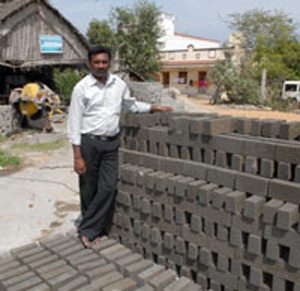
“Innovation: Eco-friendly bricks using rice husk ash
What it does: Converts ash into bricks, preventing it from ruining the enviroment
An advocate of natural farming methods for more than a decade, Kanchipuram-based Gandhi Gopalakrishnan was shocked to see lush mango farmland turning infertile by the dumping of rice husk ash (RHA). “The farmers are deceived by claims that RHA helps the fertility of the soil, when the contrary is true,” he says. The high pH content (8 per cent) of rice husk ash spells doom for the soil (ideally soil pH should remain between 6.5-7.5 per cent). “In a paddy-growing and processing district like Kanchipuram, I thought of reducing the ecological damage caused by carbon-rich RHA,” says Gopalakrishnan, president of the Natural Educational Environment Agricultural Development Society (NEEADS) that he set up in 2004.
The solution he offered has multiple benefits: convert the hazardous RHA into bricks, preventing it from spoiling the environment. It reduces the usage of bricks made from top soil, and saves trees too, since mud bricks are solidified by burning with wood. Gopalakrishnan leased out a brick factory, bought a worn-out mosaic machine and started manufacturing RHA bricks.”
Note: You could probably make the bricks with minimal cement. Rice hull ash is very similar to fly ash from power plants and so I suspect the recipe for fly ash bricks could be used. Ashtech has a recipe on their website for fly ash bricks:
Minimum 30% fly ash (60% ideal)
Cement 5-7%
Gypsum 1%
Sand or crusher dust (stone dust) balance
More at the source: India Today
Ashtech

what is the cost of overall project .Can I get any source to contact in detail about the respective work.
No contact info available. You’ll have to figure it out somehow. Experiment with lime and ash, etc.
Nice awareness over rice hull ash. Please keep it up for the effective ways to prevent and reduce pollution. Thanks for sharing.
Clay bricks can give cool n provid low temperature in the house ..is this rha brick can able to give such cool condition in house at warm period?
Generally no unless you build a double wall. It all depends on building details and the climate.
Hello Mr Owen , wanted to talk to you,
please share your email id, or contact number
Thanks and Regards
Aakash
My email is at the top of the page under About Us.
I want to start a rice hush ash brick project in Nepal since fly ash is not available over here and to save the enviourment and as well as it is a highly earthquake effected zone I need a project support with the machineries to start this project in a commercial way.
Also please inform whether Electrical consoling can be done smoothly by using this bricks or not.
Awaiting for your help and support.
Bricks are brittle and therefore prone to earthquake damage. They are not recommended for earthquake zones such as Nepal. The fact they’re made from sustainable materials is beside the point in your case.
Then which will be the suitable eco friendly low cost building material best for earthquake prone area like Nepal. Where fly ash is not available.
Further have you any idea of making houses with Bamboos and Plastic waste,used in Brazil. If so then from where I can avail the Technology.
Earthbag is best for Nepal and similar regions in my opinion. Search this blog for keyword Nepal to read about all the projects going on there. Good Earth Nepal.org has free training in Kathmandu.
Dear Sir,
I HAVE SEEN YOUR CRAFTSMAN HOUSE WITH BAMBOO AND PLASTIC BOTTLE. IF I WANT TO MAKE SUCH A HOUSE FROM WHERE I CAN GET THE HELP IN DETAIL. HOW DO I LAID THE FOUNDATION. PLEASE EXPLAIN.
The plans have all the details you need. Show them to local builders if you need more help.
Good concepts with new technology, I need this types some technology because future I will do it.
A small amount of rice hull ash is good for the soil. Rice hull ash is also called biochar. Biochar is a key ingredient in the famous Terra Preta soils of the Amazon. http://en.wikipedia.org/wiki/Terra_preta
It’s great to see a non-edible, throw away being used in such a productive way. Excellent.
You can make your own rice hull ash by burning rice hulls with a carbonizer. There are numerous videos on YouTube.
http://www.youtube.com/watch?v=qH4BzVp6wpU
I’ll post a non-cement recipe in an upcoming blog post. You don’t need cement. There are various recipes.